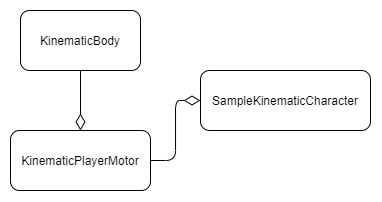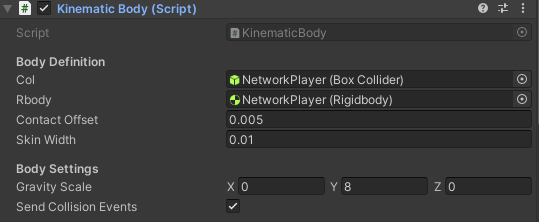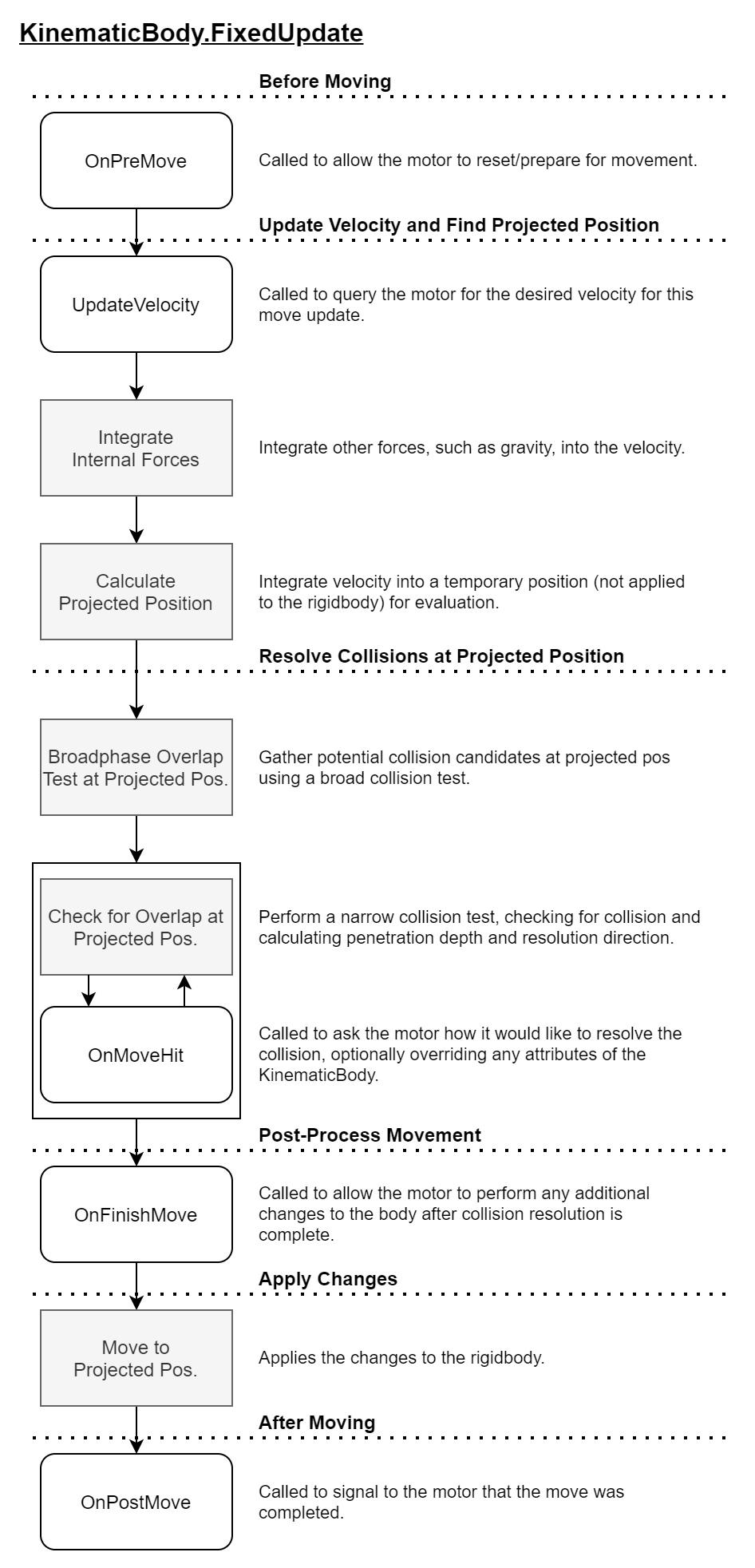Kinematic Body
A reference implementation of a KinematicBody intended for use with an upright box collider that does not rotate.
This package should support any version of Unity 2020.3 or newer.
⚠️ WARNING
This package is in an experimental state and has not been extensively reviewed or tested.
It is reflective of older games that utilize AABBs for their player volume, such as the Source Engine, which adopts the following convention:
The Player Hull must have a square footprint (like all the NPC Hulls), i.e. it can be as tall as you like, but width & depth must be the same. This is because the hull doesn't rotate with the players direction when detecting collision with the world.
Documentation
Importing this Package
NOTE
Support for OpenUPM will come as this library matures with instructor and student use.
Git UPM Dependency
The KinematicBody package can be added as a Git dependency.
Git dependencies can be added the Unity Package Manager by providing the URL and ref to the UPM package:
https://github.com/AIE-Seattle-Prog/KinematicBody.git#upm
You can also manually edit the Packages/manifest.json to include the following
in the dependencies array:
"com.aie-seattle-prog.kinematic-body": "https://github.com/AIE-Seattle-Prog/KinematicBody.git#upm"
For more information, review Unity's documentation on Git dependencies.
❗ About Git Dependencies
Git must be available on the command-line's PATH variable in order for Unity to resolve Git packages. If it is not available on the command-line, the package import will fail.
Embedded Package
You can download a copy of the upm branch
which contains the bare minimum necessary files for a UPM package. Unzip the
archive into the Packages folder in your Unity Project.
Once done, your Unity project's folder hierarchy should resemble something like the following:
Assets/
ProjectSettings/
Packages/
KinematicBody/
package.json
...
Quick Start
To review an expected setup for the character, review the sample scene under KinematicBody/Samples/SamplePlayerDemo.unity in the package.
API
The KinematicBody package provides two key classes and a sample class that demonstrates how to use it.
The KinematicBody contains the bulk of the logic that defines the volume of the kinematic body and any relevant APIs for querying with it.
It is referenced by the KinematicPlayerMotor which implements the IKinematicMotor interface providing implementations for methods that will be called by the body when it performs its "Move" update.
Finally, player inputs are gathered in a separate class, such as the SampleKinematicCharacter (described below) and provided to the motor for processing.
✨ NOTE
Users looking for a basic humanoid motor can use this library as-is without modification or much additional work aside from integrating it into their player prefab and providing the appropriate inputs.
Manipulating the Motor
The KinematicPlayerMotor is referenced by the SampleKinematicCharacter
which calls the KinematicPlayerMotor.MoveInput method to provide a world-space
input vector which tells the motor which way it should move.
/// <summary>
/// Sample character script demonstrating how to send inputs to a motor. Provided for reference purposes.
///
/// Moves in world-space (not relative to any particular camera)
/// </summary>
public class SamplePlayerCharacter : MonoBehaviour
{
// The motor we're controlling
public KinematicPlayerMotor motor;
private void Update()
{
// send move inputs to motor
motor.MoveInput(new Vector3(Input.GetAxisRaw("Horizontal"), 0.0f, Input.GetAxisRaw("Vertical")));
// send jump inputs to motor
if (Input.GetButtonDown("Jump"))
{
motor.JumpInput();
}
}
}Users should implement their own "Character" script that can provide inputs with respect to other systems like their camera, current gameplay state, or other game-specific considerations.
Collision Events
When a KinematicBody moves, it gathers collision and trigger events for further processing.
User code can query this from the body by calling KinematicBody.CollisionCount
and KinematicBody.TriggerCount on an instance to determine how many collisions
or triggers it encountered. These can then be retrieved by calling
KinematicBody.GetCollsion and KinematicBody.GetTrigger accordingly.
⚠️ Events are not zeroed out between frames.You may encounter stale events if accessed too early or accessing elements at indices at or beyond the value returned by
CollisionCount/TriggerCount.This may raise an exception in the future to alert of any misuse of the API.
These are available after KinematicBody has run its FixedUpdate routine for that frame.
⚠️ The max number of events per type is 32 (i.e. 32 collisions + 32 triggers = 64 total)This is defined by a constant in the KinematicBody.
Collision Messages
The KinematicBody can mimic "OnXXX" messages in Unity by enabling the "Send Collision Events" boolean on the KinematicBody.
Once enabled, components can recieve collision messages by implementing methods with the following signatures:
// review KinematicBody.cs for full API expose in a MoveCollision
void OnKinematicCollision(KinematicBody.MoveCollision collision)
{
// react to collision
}
void OnKinematicTrigger(KinematicBody.MoveCollision trigger)
{
// react to trigger
}These are sent after OnPostMove has been called by the KinematicBody.
The events are received by both objects involved in the collision:
| Body | Other |
|---|---|
| Body game object | Rigidbody game object |
| Body game object | Rigidbody game object comprising a compound collider/trigger |
| Body game object | Collider/trigger game object (if no Rigidbody) |
This mimics the same rules that Unity applies when determine which game objects receive collision messages with normal Rigidbody objects.
KinematicBody Lifecycle
When the KinematicBody moves in Fixed Update, it performs multiple phases of collision detection. At each stage, callbacks are called by the body to defer handling to the motor to allow for varying types of collision responses.
All of the steps listed in a round white box are callbacks that are called by the body on the motor assigned to it at the appropriate stage in the process.
Steps shown in gray and rectangular boxes are performed internally by the body and may not necessarily map 1:1 to a method.
IKinematicMotor Interface
The motor registers these callbacks through its implementation of the
IKinematicMotor interface:
// This is an excerpt from KinematicBody.cs
//
// See source file for full XML documentation on return values/parameters/etc.
public interface IKinematicMotor
{
Vector3 UpdateVelocity(Vector3 oldVelocity);
void OnMoveHit(ref Vector3 curPosition, ref Quaternion curRotation, ref Vector3 curVelocity, Collider other, Vector3 direction, float pen);
void OnPreMove();
void OnFinishMove(ref Vector3 curPosition, ref Quaternion curRotation, ref Vector3 curVelocity);
void OnPostMove();
}By implementing these callbacks, different types of objects can use the KinematicBody to implement different types of movement behavior. Humanoid characters may choose to ignore inputs on the Y-axis. Other types of bodies like a helicopter would use Y-axis values to apply vertical lift.
License
This work is licensed under the MIT License. See LICENSE.md for details.
Copyright 2021-2022 (c) Academy of Interactive Entertainment


